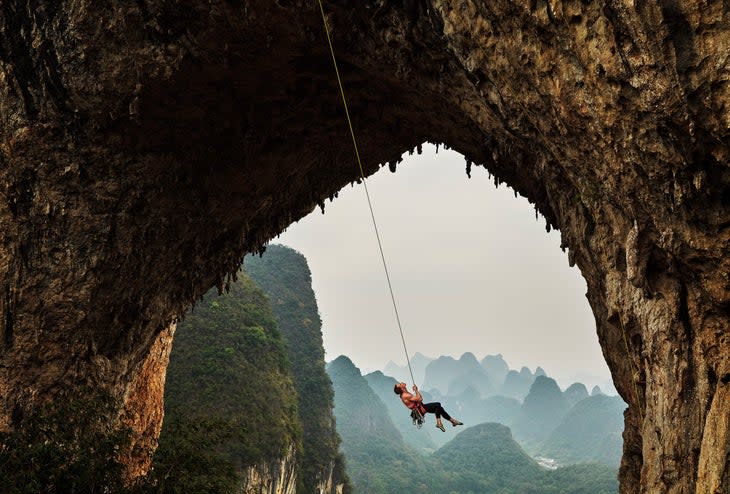Don’t Drop Your Partner, and Other Ways to Not Screw Up on Belay
This article originally appeared on Climbing
In 1980 my college roommate, Mark Herndon, fell 100 feet on a two-pitch route. I was belaying from a stance at the end of the first pitch, cooling my feet, shoes off. Mark had just cruised the second-pitch crux, a near-holdless paddle up granite glass, and was nearing the end of a 50-foot runout above the route's only lead bolt when he slipped.
Back at the belay, I figured that the serious climbing was over and was gazing stupidly at my toes when a giant loop of slack suddenly spooled down the face. I glanced up to see Mark looming larger and larger.
I froze, horrified by the prospect of witnessing--and catching--the daddy of all falls. As Mark scorched past me, I caught a strong whiff of his E.B.s burning on the rock. Panicked, I reeled in an arm- load of slack--just enough to catch him a few feet above a sea of knobs. Instead of splintering his ankles, or worse, Mark walked away with a serious road-rash and a backside full of quartz granules that my mother, a nurse, carefully tweezed out of his buttocks that evening.
That day I learned that dropping trou in front of your partner's mother is a humbling procedure, but, moreover, people can--and do--fall when you least expect it. Be ready.
How you hold the rope is just one aspect of the belay--no more or less important than vigilance, rope management, how and where you stand, and communication.
DON'T BE A SHORT-ROPE DOPE
In 2004, then 20-year climbing vet Wolfgang Schweiger was dropped 30 feet into talus when his belayer lowered him off the end of his rope. Schweiger survived, but was critically injured. In the increasingly common accident, the belayer believed the rope was long enough to lower Schweiger to the ground, when in fact it wasn't. Year over year other notable climbers, weekend warriors and beginners have been dropped, often sustaining serious injuries. Never think that your belay rope is long enough for a climb, know it is.
Do this by:
1. Knowing the climb. Lowering accidents often occur on routes that the belayer or leader hasn't done before, and one or both underestimate the pitch length.
2. Knowing the rope. Check the tags on the rope ends for the rope length. If a tag is missing, one end of the cord has probably been trimmed off, shortening the rope. Beware!
As an additional precaution, do as AMGA rock guide Adam Fox calls "closing the system" by having the belayer also tie into an end of the rope. When both ends of the rope are tied to a person, it is impossible to lower the climber off his end. Alternately, tie a knot in the free end of the rope. Knotting or tying into both ends of the rope might seem unnecessary when you are sure that your rope is plenty long, but it should be a habit.
KEEP YOUR EYE ON THE BALL
When you belay, always concentrate on your leader, watching with your face upturned or wear belay glasses. Do not be distracted, even by the climber who strolls along and asks for beta or by the dog soaking your pack. Don't talk to anyone when you are belaying. If someone tries to strike up a conversation, say, "I can't talk while I'm belaying, talk to you after he finishes." Similarly, avoid asking questions of someone who is belaying or climbing. Lack of attention is a leading cause of belay accidents. All it takes is one mistake to create an accident you will always regret.
BE A GOOD MANAGER
The amount of rope the belayer pays out varies and is a matter of experience and common sense. Bottom line: catch the climber. The second basic precept is to keep the slack to a minimum, to keep falls as short as possible. In some situations--for example, when a climber is seconding just above the deck--you'll need to keep the belay tighter than you normally would.

The amount of rope the belayer pays out varies and is a matter of experience and common sense. Bottom line: catch the climber.
However, be careful not to keep the rope too tight when the leader is moving fast, traversing or executing a dyno, in which cases you might either pull him off or aid him, voiding the hard-earned clean ascent. Another very common error, especially in sport climbing, is to "short rope" the leader by not paying out enough slack for the leader to clip overhead protection. A sticky belay can even cause the leader to fall. Watch the leader's moves, and anticipate the clips. Pay out slack as the climber reaches down for it, not as he tries to pull up the rope. Often, you can feed out a couple of feet of slack simply by taking a step or two forward (or backward to quickly pull in slack).
When the climber is just leaving the ground, pull the rope as taut as possible to minimize the chance they’ll deck on the opening moves. “Pre-stretching” the rope by weighting it before the climber starts up will reduce rope stretch.
GROUND SCHOOLED
Regardless of whether the belayer is anchored, never belay sitting. Lounging around makes it more difficult to control the rope, and promotes inattentiveness. Always belay standing, with two hands on the rope, eyes on the climber.
Many climbers never leave the comfort of the ground to belay. While a ground belay may not involve the inherent dangers--such as anchor failure--associated with multi-pitch belays, a ground belay has dangers all its own. Whether the belayer should anchor on a ground belay is a matter of judgment. If there is any possibility of getting pulled off a ledge, dragged across the ground into obstacles, or jerked up to hit the underside of an overhang, the belayer should anchor, and wear a helmet when there’s a risk of being slammed into the rock.
At sport crags, you'll seldom see the belayer anchored. For the most part, mobility is useful here. A mobile belayer can, as previously discussed, step forward to provide instant slack for a desperate clip, or step back to take out slack quickly. On steeper sport routes, an unanchored belayer might also "soften" a fall by jumping up the moment he feels the falling leader's weight come onto the belay. In cases where the belayer is sizably lighter than the leader, the belayer can be launched into the air, naturally softening the fall but also possibly slamming the belayer into the wall or pinning the belay device against the first piece of pro, causing the device to jam open. In such a case, and especially when the leader greatly outweighs the belayer, tie down.
COMMAND CENTRAL
Communication between the belayer and climber is a critical but often botched aspect of belaying. Even experienced climbers become careless to the point where they seem to rely on telepathy.
We use many signals to communicate our intentions, but the simpler and the more common, the better. It's especially important to use commands that can't be misinterpreted. The following are the most universal.
When a climber is ready to climb, he asks, "Am I on belay?"
The belayer says, "Belay on."
The climber then says, "Climbing," and climbs after the belayer replies "Climb on."
When the climber needs slack to make a clip or a move, he says "Slack." When he needs the rope pulled tight, he says "Up rope." Many climbers use "Take" when they need the rope pulled tight so they can hang, but be careful, "Take," from a distance or in the wind can sound like its opposite command, "Slack."
Before a climber leaves the ground he must let the belayer know whether he plans to rappel or lower. If the climber intends to rappel, he simply ties into the anchor, tells the belayer he is "off belay," sets up his rappel, and raps down. Never take someone off belay unless you're positive he is off; shout for repetitions until you are sure.
If a climber intends to be lowered, never unclip him from your belay device. If the climber needs slack to clean an anchor, he'll call for "slack." Pay out slack, but keep the climber on belay the entire time.
Develop a signaling system for situations where you cannot hear one another. One common system is to have the leader tug sharply on the rope three times to signal "off belay."
After the climber tops out on a pitch, but before he weights the rope to be lowered, he must always ask if the belayer is ready. The climber shouts, "Got me?" then doesn't move until he hears, "Yes," or "Got you." If the belayer and climber can see one another, establish eye contact for affirmation. If multiple teams are climbing, the belayer and climber should call each other by name, to confirm that shouted commands are really meant for them. For commands that don't require a response, the belayer should reply with "thank you" or "ok" to indicate that he heard the command.
Before lowering a climber, the belayer must make sure there's enough rope for the climber to reach the ground. A middle mark on the rope will tell you if there's enough slack, but most of these marks disappear with wear, and one side of the rope might be longer than the other. Again, always knot the free end of the rope or close the system by tying into both ends!
You won't always be able to see your partner or hear him well--if the route is long, or traverses or the wind is blowing--so belt out the commands. Don't climb or take someone off belay until you know he is off. When in doubt, wait and keep yelling.
Develop a signaling system for situations where you cannot hear one another. One common system is to have the leader tug sharply on the rope three times to signal "off belay." The belayer then tugs back three times to show understanding and also shouts "off belay." When the leader is ready to belay, he gives three tugs. The second then gives three affirmative tugs back before unplugging the belay and climbing.
Problem is, it can be easy to mistake a leader's jerky movements or tugs for slack as the off-belay signal. And, if there's rope drag it can be tough to feel the tugs in the rope. When in doubt, keep the climber on belay. It's better to frustrate the leader by burning time sitting on belay than to drop him. Usually, after enough time has passed, all the rope has been pulled up and the belayer feels the occasional repeat groups of three sharp tugs on the rope, he'll know what the leader wants.
This article first appeared in Rock and Ice Issue 147.
For exclusive access to all of our fitness, gear, adventure, and travel stories, plus discounts on trips, events, and gear, sign up for Outside+ today.

